美国建筑师和设计师,迈克尔坟墓佤邦s part of the “New York Five” group and is considered one of the fathers of postmodernism. Despite his building and home accessories standout designs being eccentric, he’d argue that“good design should be accessible to all”.
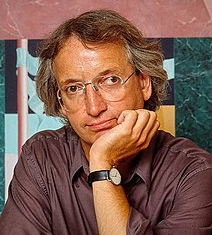
Image source:https://en.wikipedia.org/wiki/Michael_Graves#/media/File:Michael_Graves,_architect,_Princeton,_N.J.jpg
Master of the Postmodern
Graveswas born in1934inIndianapolis.After high school, he went on to get his bachelor’s in drawing; after receiving his BA, he graduated fromHarvardto obtain his masters’ degree in architecture. Graves also attended an art school inRome进一步培养热爱画画,drawing remained one of his favorite activities throughout his entire life.He founded and directed the Michael Graves Architecture & Design, with offices all the way toNew York,and from1964, he becameprofessor emeritusat theUniversity of Princeton. Considered one of thefathers of postmodernismin architecture, Graves was part of theNew York FivewithRichard Meier,Peter Eisenman,Charles GwathmeyandJohn Hejdukche, a group of architects who redefined the modernist movement in the1970s. Opposing the formalism and minimalism in vogue at the time, the ‘five’ proposed a return toornamentation, tocolors, to thebizarre shapes. One example is the Portland Building in Oregon, perhaps the most famous and most controversial work, the Humana insurance skyscraper in Louisville and the Central Library in Denver.
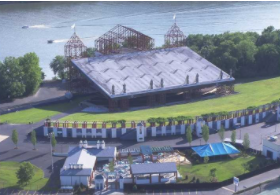
Image source:https://en.wikipedia.org/wiki/Riverbend_Music_Center
Image source:https://spinalpedia.com/blog/2015/03/sci-superstar-michael-graves/
Graves’ Most Important Works
ThePortland Buildingis considered one of the most famous works of post-modern architecture. It is characterized bysymbolic elementson its facades, which are in contrast to the functionalmodernistarchitecture of that time. In1979, in Portland (USA) a competition was launched for designing thePortland Service Building. Graves participated in this competition, distinguishing himself from his challengers who used expensive materials such as glass and concrete. Indeed, he preferred to rely on acolorful low-cost design, that was the key to his victory. One of the building’s goals is to create acontinuous connectionbetweenpastandpresent. As Graves explains, it is
[…] a symbolic gesture, an attempt to re-establish a language of architecture and values that are not part of the modernist homogeneity.
This building has four white regular facades with the addition ofpillarsandkey stones. From the outset, the building has been the subject ofcriticismbecause both the tapes and the medallions were not considered to be such a level as to characterize anofficial government building. Other people have instead criticized the excessive presence of symbolism and references to the past. A more serious and reasonable criticism regards theabsence of functional elementssuch as the arches that flank the facades that are difficult to access.
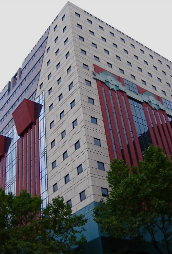
Image source:https://search.creativecommons.org/photos/fc39ba58-b0f7-4e46-b579-59c19e7d6a6bbyChris Harley
TheWalt Disney World’s DolphinandSwan Resort Hotelwere built in the late1980s. For this project, Graves and his collaborators took into consideration both thearchitecture of the past, the landscape and the climate of Orlando to create buildings that wouldstand outfrom those already present in the city. Indeed, these buildings were characterized bybrightly colored,boldly geometric volumesandanimal-shaped pediments. This project consists of two buildings: the largestDolphin hotelis anchored by a giant triangular element in the center, and then there is theSwan hotel. Both hotels are characterized byexteriors with large-scale motifssuch as banana leaves covering the dolphin and abstract waves near the swan. The presence of ornamental animals placed on the roofs of the building immediately catches the eye. Indeed, they are used as recognizable and distinguishable elements. Both hotels cover a square area that exceeds two million square feet sitting opposite each other on either side of a lake. However, they are connected by a causeway across the waterside,
which was renamed the “Michael Graves Causeway” when the American architect died.
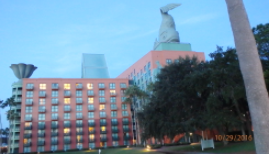
Image source:https://search.creativecommons.org/photos/3ac421ad-9bc7-42dd-8344-7e54378bf060byosseous
“My Favorite Project Is Always The Next One”
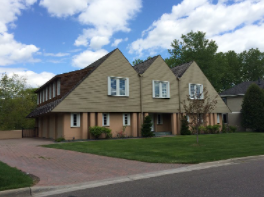
Image source:https://commons.wikimedia.org/wiki/File:2016-0515-CedarGablesHouse-by-MichaelGraves.jpg
Borrowing heavily from the past, Graves often combined traditional details with whimsical flourishes withprovocativeandinnovativepostmodernist designs. He brought color and playfulness to tall while at the same time designingeveryday objectssuch as teakettles and kitchen trashcans for ordinary consumers. Graves was a great architect who was able to be intimate and monumental, iconoclastic and reverential, challenging and coddling often all in the same building. He was a very hard worker sophisticated inart,literatureandhistory, but he always brought these interests back into everyday life, designing home furniture, teapots, and other household items. His teapot remains one of his favorite designs. He moved from an abstract and ornate modernism to a deceptive landscape embrace of traditional pre-modern planning strategies. Graves has repeatedly stressed that the goal of his profession was to“delight the soul through the buildings”and thanks to any element that compose them, external and internal, from windows to toilets.
“Good design should be accessible to all”, he argued.

Image source:https://search.creativecommons.org/photos/cad65480-6ffc-4d99-ad79-da8b6894cb7bbyDidriks
Info sources:
https://www.archdaily.com/407522/ad-classics-the-portland-building-michael-graves
